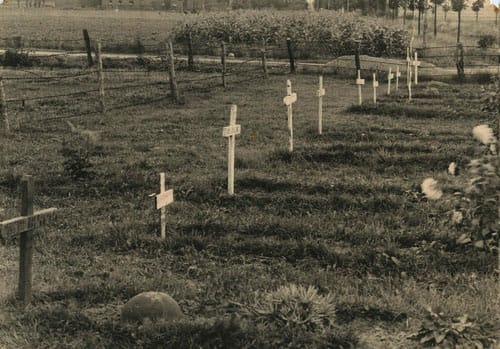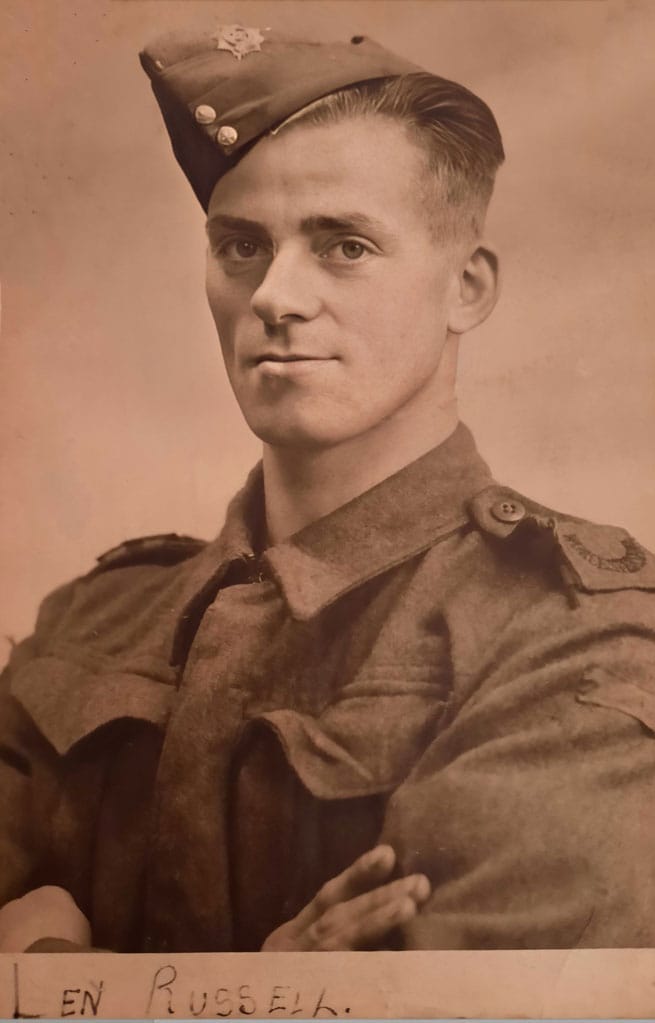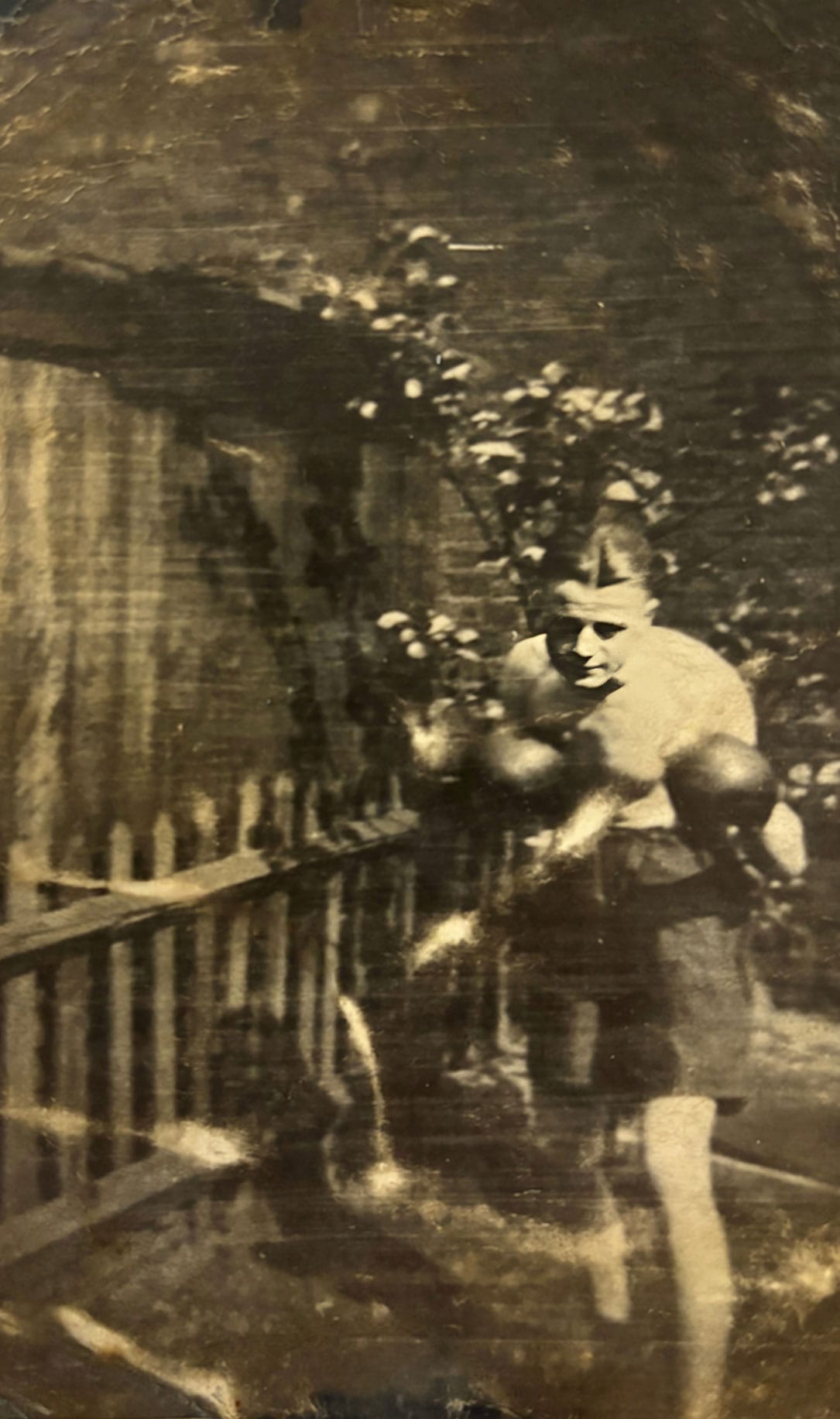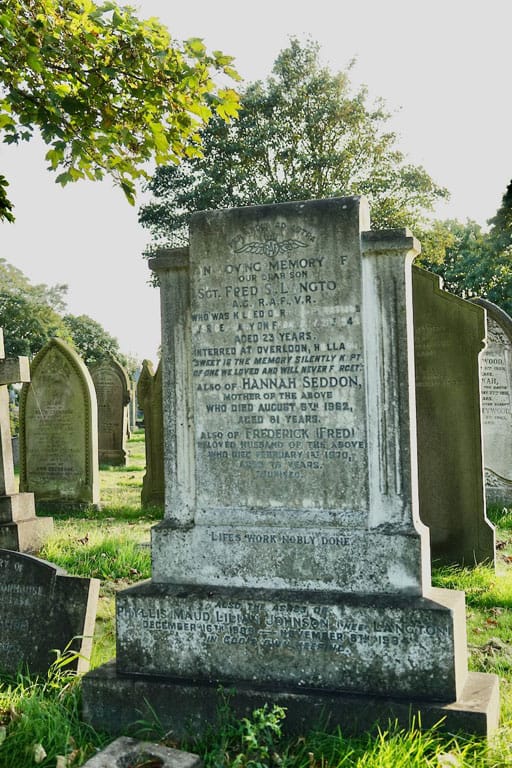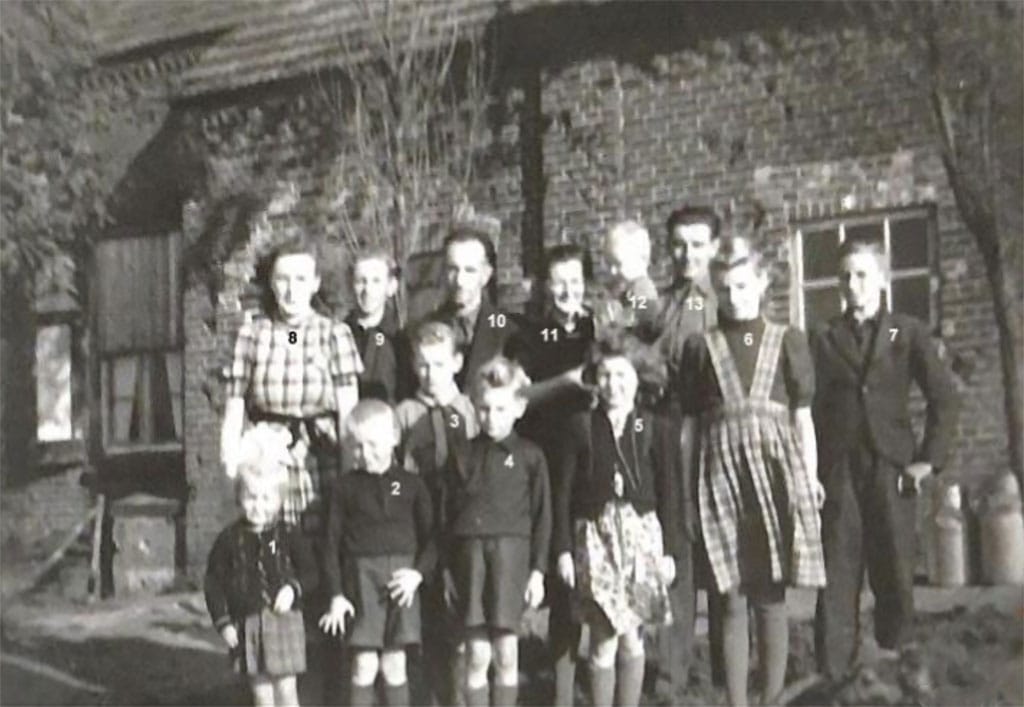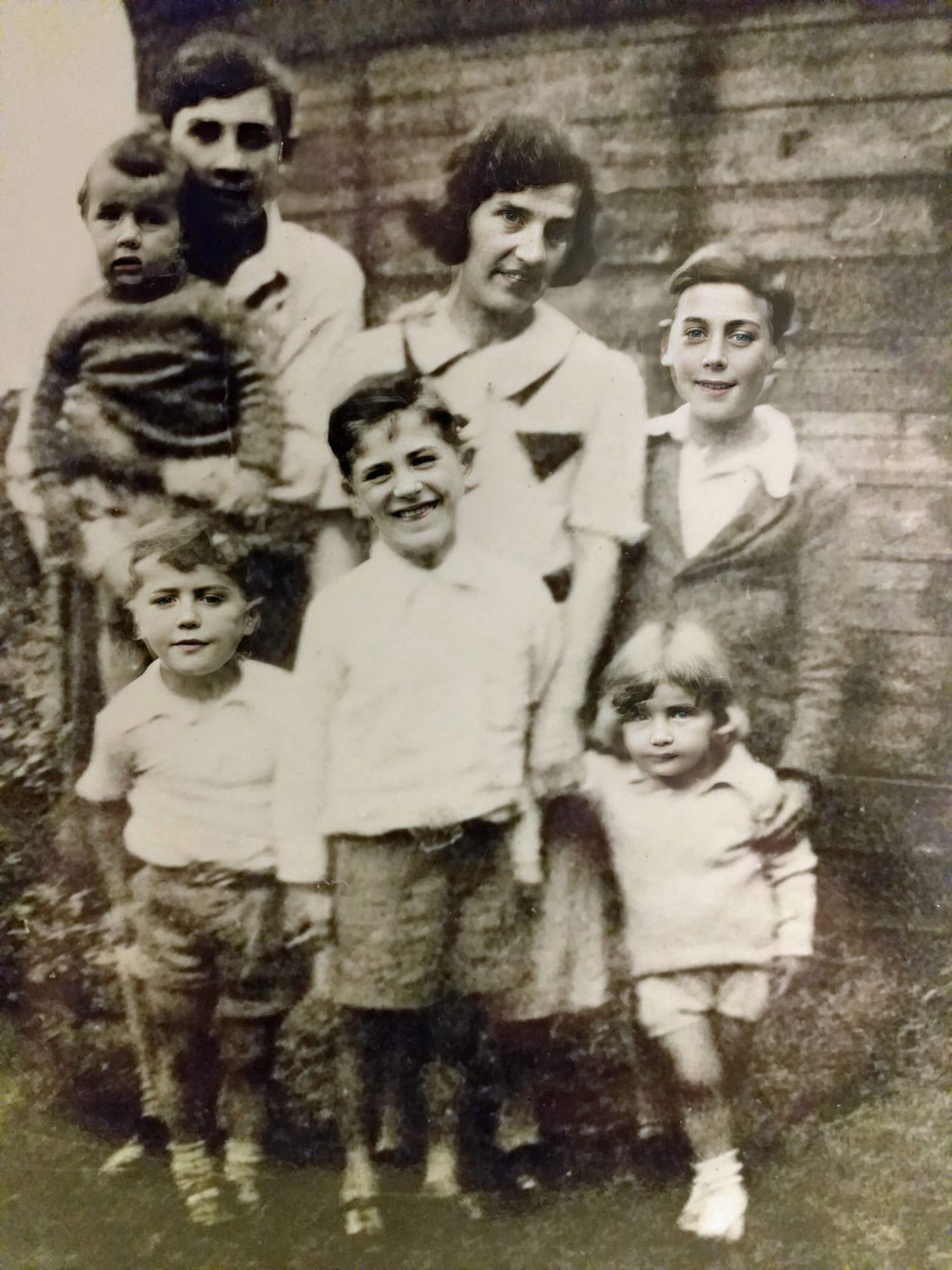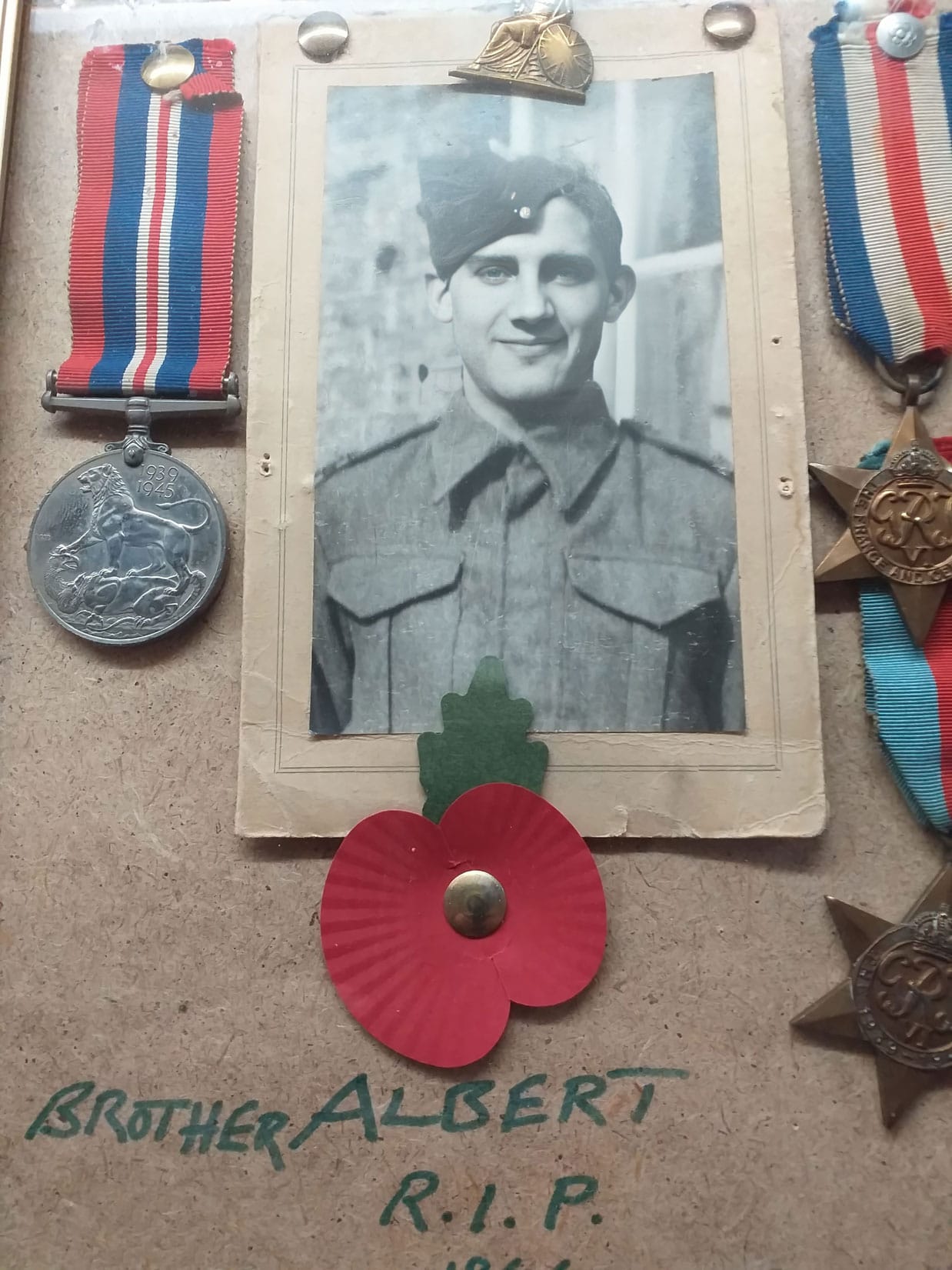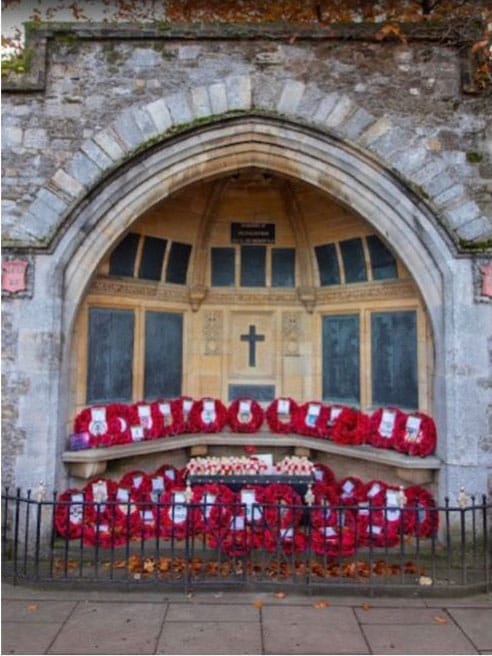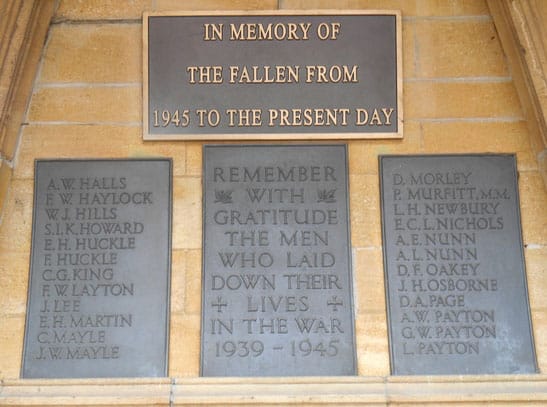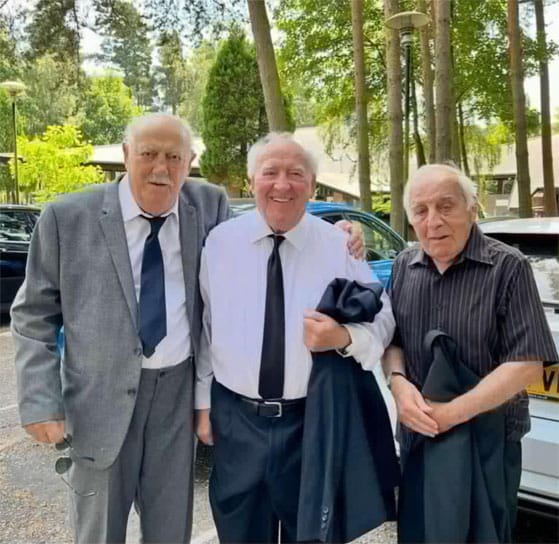Russell John
Russell | John
First names
John
Age
22
Date of birth
26-02-1922
Date of death
06-12-1944
Service number
14325954
Rank
Sapper
Regiment
Royal Engineers, 253 Field Coy.
Grave number
I. E. 8.

John Russel
John Russel

Grave John Russell
Grave John Russell
Biography
John Russell (Service No. 14325954) was killed in action on 6/12/1944. He was aged 22 and a Sapper in the Royal Engineers, 253 Field Company. He was initially buried at Cemetery Huijsmans, Rieterdreef and subsequently re-interred on12/5/1947 in grave I. E. 8 at the Overloon Commonwealth War Graves Cemetery in Overloon. His inscription reads “Too good in life to be forgotten in death. Mum, Dad, Brothers and sisters.”
Family background
John Russell, who was known as Jack, was the son of Arthur Albert Russell and Mary Ann Huntington who had married in 1900 in Aston, Warwickshire.
Jack was born on 26/2/1922 and was the second youngest of eleven children as follows, all born in Aston: Arthur Leonard 1900, Albert 1901, Wilfred George 1903, Dora 8/1/1907, Frederick William 1909, Leonard 6/6/1911, Ernest 1914, Lillian 3/8/1916, Henry 1919, John (Jack) 26/2/1922 and Howard R 19/3/1924.
Arthur Russell had been born on 6/10/1881 and Mary on 6/11/1881 – both in Birmingham.
In 1901 Arthur and Mary were living at 2, Webster Street, Victoria Terrace, Aston Manor, Aston, Warwickshire. With them was their first child, Arthur Leonard. Arthur (Snr) was working as a Machine Tool Maker and Mary was a Jeweller’s Polisher. However, Arthur Leonard died in 1905 aged 5.
In 1911 Arthur and Mary were living at 77 Clarendon Street, Aston Manor, Warwickshire. Arthur was working in the Gun Trade. With them were their first four surviving children. However, Frederick William died in 1912 aged 3 and Ernest in 1918 aged 4.
By June 1921, Arthur and Mary were living at 2, Back 112, Clarendon Street, Aston, Birmingham, Warwickshire with their first five surviving children. Arthur was working as a Machine Tool Maker for Scott Ltd. Albert was working as a Tin Smith, Wilfred as a Glass Blower at John Welford (but was suspended until a strike was over), Dora was working in a Warehouse for Miller & Co.
Albert married Beatrice L Hall in 1928 and had three children. Wilfred married Winifred Rose Stokes in Yardley in 1928 and had four children between 1929 and 1936, though Wilfred died in 1937 and Winifred remarried.
Dora married Robert J Thornton and Leonard married Annie Nash in 1933 in Birmingham. Dora had four children between 1936 and 1945. Leonard and Annie had two children in 1934 and 1938.
In September 1939, Arthur and Mary were living at 98 Clarendon Street, Birmingham. With them were their children Lillian, Jack and Howard. Arthur was working as a Turner (General Engineer). Lillian was working as a Dress Finisher, Jack as a Sheet Metal Worker in the Motor Trade and Howard as a Transformer Draughtsman. It is not certain what had happened to Henry by this time.
Military Career
Jack enlisted on 5/11/1942 in the Royal Engineers. On 16/12/1942 he was in the 3rd Training Battalion Royal Engineers. He was assigned to 224 Field Company on 11/5/43. This company had joined VIII Corps Troops, RE in March 1943. By July this Corps formed part of Second Army in 21st Army Group, training for Operation Overlord.
His older brother, Leonard, served as a Private in the 1st Battalion of the Worcestershire Regiment in WW2 (No. 5258398). Sadly, he was killed in a tragic accident on 20/1/1944, aged 32. He was one of a Platoon which got lost in the mist in an exercise on Brighton beach while practicing for the D-Day landings. They had corrected their mistake and were heading towards their correct objective when they were subjected to heavy machine gun fire from tanks. A safety officer said that when he realised the machine gun fire was hitting the ground he fired his pistol for them to stop. However, they did not do so until he fired again. Leonard received several bullet wounds and was taken to hospital. A telegram was sent to his wife to say he was at Brighton Hospital and she left for the train straight away. After she’d left, another telegram came to say he was actually at Hove Hospital, but she didn’t find this out until she arrived in Brighton. By the time she got to Hove, he had died. A verdict of death by misadventure was returned at his inquest. The Captain in charge of Leonard’s platoon described him as one of the finest soldiers in it.
Jack himself seems to have required hospital treatment at the Royal Victoria Hospital in Westbury, Wiltshire on 3/5/1944. He was discharged on 13/5/1944. On 22/5/1944 he was assigned to 50 Reinforcement Holding Unit and embarked for France on 3/6/1944 as part of 39 Reinforcement Holding Unit, landing on 6 June, D-Day. He was then assigned to No. 2 Platoon of 253 Field Company on 14/6/1944. A Royal Engineers Field Company was manned by men from a wide variety of trades so they were equipped to deal with almost anything that confronted them. Jack’s civilian role as a sheet metal worker will have stood him in good stead.
The Company spent June, July and August in Normandy, supporting the other regiments in road clearance, mine laying, road making, bomb disposal, bridge building and other tasks such as the creation of water points.
By 17 August they had reached Frenes. The book “History of the 253rd (West Lancashire) Field Company Royal Engineers D-Day to VE Day” says “And now began the real period of liberation, Sappers working on checking road verges were greeted with joy and excitement, they came back in the evening with their trucks decorated with flowers and scribbled all over with autographs in chalk. They waved from the top of their vehicles and knocked back calvados and cider shouting ‘Vive la France.’ No one’s spirits could have been higher and by the time the Company entered Flers on August 18th contact with the enemy had been lost. It was not to be regained until we reached the Escaut Canal in Belgium.” They were able to enjoy an ENSA show in the town’s theatre. However, work continued as in late August they were also involved in training the Division in assault river crossings.
On 3 September, the Company moved from Flers to Richeville, crossing the Seine at Les Andelys. There was a period of rest with training on bridging operations and watermanship. On 10 and 11 September they continued their progression northwards, crossing into Belgium and past Louvain to reach the village of Rillaar after a 28 hour continuous journey. While here, they spent time training for an assault river crossing but also having a good time in Brussels in the evening. It was noted in the War Diary that “A grand welcome has been extended to the troops by the civil population.”
They remained here for some time before proceeding on 17 September across the Albert Canal to Petit Brogel just north of Peer. The unit was now in the front line on the opposite side of the Escaut canal which was held by the enemy. During the night of 18/19 September No. 1 and 3 Platoons assisted 9th British Infantry Brigade to cross the junction of the canal at Lille-Saint-Hubert, with the entire Company ending the day in the Hiekant area. On 20 September, No. 3 Platoon proceeded with road sweeping equipment in the area towards Maarheeze over the border of the Netherlands while the other two were held in readiness to demolish bridges over the Maastricht Canal on the Dutch side of the border near Weert. However, it transpired the next day that the enemy had already demolished the bridges. By 23 September, two Platoons moved into the Netherlands near Hamont, ending the day at Zomeren. The other remained with 9 Infantry Brigade and were at Deurne by 1 October.
By this time, it was known that Operation Market Garden had failed to take the bridge at Arnhem so the hopes of a rapid end to the war were fading.
On 1 October, the Company as a whole moved north again to Escharen which is between Nijmegen and Mill. From 7 to 10 October, they were involved in route maintenance and organising mine clearance teams with little idea of what was to come next. On 10 October it was decided that the west bank of the Maas was to be cleared down through Overloon and Venray to Venlo.
On 11 October the unit moved south to Oploo and, on 13 October, two platoons supported Operation Aintree by clearing gaps through mine belts and developing forward routes in support of the 2nd Battalion of the Royal Ulster Rifles and the 1st Battalion of the King’s Own Scottish Borderers. This continued the following day with route clearance south of Overloon. Overloon had finally been captured that day. Some of the troops remained at an advanced location while others returned to Oploo.
The focus then shifted to the route from Overloon to Venray where there was a need for bridge laying activities to cross the Molenbeek which was a major obstacle en route for Venray. During the night on 16 October No. 1 Platoon built a trestle bridge over the Molenbeek and No. 2 Platoon laid down culverting and filled in the gap opening the road to tanks the next morning. To do so involved an army of tippers pushing down ruined houses to provide the rubble to fill this formidable gap which could not be bridged by a Bailey owning to the presence of a capsized tank midstream. This was later to be known as “Forth Crossing”. Shortly afterwards, the 185th Brigade took Venray and the advance came to a halt with enemy still on the west bank of the Maas.
By 19 October the entire Company was based at Overloonsche Vlak which is on the Oploo road to the west of Overloon. Bad weather and bad roads were making supply difficult so work continued on the maintenance of routes and crossing approaches and mine clearance – and also the clearance of tracks for tank recovery. During the rest of October, the company continued with these tasks. They also assisted the REME with the recovery of an Assault Bridge north west of Venray, clearing lanes for tank recovery and even with the recovery of bodies. Many of these latter tasks would have been in the aftermath of the difficulties encountered in capturing Overloon and crossing the Molenbeek.
The Company remained at Overloonsche Vlak into November with similar activities. They helped to build a corduroy road called the “Fir Track” and provided training to infantry regiments in the laying of mines. Mines were laid at Mullen and Vierlingsbeek to protect the Venray thrust from an attack from the east. Among other tasks, on 7 November, it was also noted that there was an almost daily task of burying dead cattle.
On 12 November the platoons’ personnel acted as infantry, patrolling and manning forward areas at Vortum which is south of Boxmeer, facing the River Maas. At this point the unit was relieved of route and road tasks. The men assigned to patrol duty also laid trip wires and mines. It was while here that the Company lost Sgt Edgeley who is also buried at Overloon. They were relieved of the patrolling duties on 16 November.
By 20 November, there was word of a fresh push to the south (Operation Peacock) so the unit moved its base from Overloonsche Vlak first to Heipt on the outskirts of Venray and then, on the 24th, to Heide a few miles south. On 21 November No. 3 Platoon constructed a 30ft Bailey Bridge over a gap to the south of Heide and prepared a track in readiness for an attack on Horst. On 22 November, the British 9th Infantry Brigade began the advance and, finding Horst abandoned, pushed further south reaching the railway line at Grubbenverst. During the follow up on 23 November the Company had to clear roadblocks of trees between Venray and Horst. On 24 November, No. 2 Platoon assisted with the erection of a Bailey Bridge at Horst.
On 28 November, the Company HQ moved back to Hoofbrooding near Mill, leaving the three platoons at Heide. On 29 November, No. 2 Platoon started building a 70ft Bailey Bridge at Meerlo, to the south east of Venray. No 1 and 2 Platoons then joined HQ at Hoofbrooding. Meanwhile on 29 and 30 November No. 3 Platoon supported the 2 RUR for an attack in the Meerlo/ Wanssum/ Blitterswiijk area. This attack was heavily opposed and the RE parties were not used so withdrew to Meerlo. The other platoons were employed in road maintenance on the St Hubert / Haps / Oeffelt and St Anthonis /Boxmeer roads.
The last of the enemy had been cleared from the western bank of the Maas. The winter was now well advanced and the weather was wet and cold, making it impossible for either side to make any big move before Spring.
On 2 December, the platoon based at Meerlo returned to the rest of the Company near Mill. They were again involved in maintaining roads. Their area of responsibility was modified to align with that of 185 Infantry Brigade. It was generally to the south of Cuijk, north of Overloon and west of the Maas. Over the next two days maintenance continued. A party examined the Vortum to Verlingsbeek area for enemy mines and another group were making a railway line from Mullem into a track for jeeps. A ten day Field Engineering course was instigated for some members of five infantry regiments.
However, on 6 December the War Diary states that an “R mine exploded when being neutralised killing Spr Russell and wounding L/Cpl Johnson, Sprs Crooks & Dilks.” It says that on December 7 Spr Russell was buried at an informal cemetery at Huijsmans’ farmhouse on Rieterdreef which is close to the base they had used at Overloonsche Vlak.
Aftermath
Jack’s father, Mr A Russell of 98 Clarendon Street, Birmingham who was his next of kin was informed officially of his son’s death on 12/12/1944. This news would reach him just 11 months after the death of his other son, Leonard. He also received a message of sympathy from the King and Queen.
Shortly after that, Mr Russell received a letter from Major ET Collins of the 253 Field Company, Royal Engineers which was written on 7 December, the day after Jack’s death. He says:
“Dear Mr Russell.
I wish to extend to you, on behalf of myself and the whole company, our very deep sympathy in your great loss.
When you receive this letter, you will already have been notified of Jack Russell’s death yesterday, but I am sure you will want to know more about it.
He was engaged in lifting and finding German mines when one exploded and killed him instantly. The mine must have been damaged by shellfire or some other cause and thus became unsafe to handle. He was extremely clever with mines, but in this case, it was quite impossible for anyone to tell that the mine had been affected. Three of his friends, who were with him were wounded, but will, I think, be all right.
Your son was a splendid soldier, always volunteering first for any duty, and always very cool and good in everything he did. He was immensely popular in his platoon and is greatly missed.
He was buried today quite near here and beside one of his friends. The service was conducted by a Church of England Chaplain in my presence and in the presence of your son’s officers and friends.
We who remain are determined that his sacrifice will not be in vain.
Yours sincerely,
Edward Collins.”
The friend he was buried alongside would be Sgt. Frank Edgeley and he is still alongside him at Overloon.
Major Collins himself was killed in action on 28 March 1945.
Jack’s brother Howard had written to his brother on 7 December, not knowing that he had been killed the previous day. This letter was returned to Howard in an envelope with post mark 15 December with the following stamp “It is regretted that this item could not be delivered because the addressee is reported deceased.”
It must have been extremely sad for Howard to re-read the hopeful words he had sent to Jack which he never received. Neither did he hear this latest news of his family and friends. His letter said the following:
“Dear Jack,
We had a letter off you yesterday and in it you have said how you wished to dispose of your Ten Pounds.
Well, Jack, all of us at home very much appreciate the fineness of this thought, and altho’ you more or less said that you were determined that we should accept it, we all feel that we couldn’t possibly do so. When you sent your letter it is most likely that you had not heard of leave that all you chaps will be getting.
So what we think the best thing to do is to keep it for you for when you have your leave and then you can have a good time with your savings and what a time we shall have. I tell you, Jack, if I don’t get drunk when you come home on leave, I swear I shall never have another drop.
Well, Jack, I hope that you won’t be annoyed at us for not accepting the money, but if we did, we should never seem to have a clear conscience.
Well Jack, to change the subject, Reg. came home on Tuesday, but up till now everything in the garden seems lovely. She stayed at the house, which surprised me very much, and it seems as though they are Darby and Joan.
About those newspaper cuttings that you said you didn’t receive, I have thought of another possible thing that happened. In my last letter I sent you some newspaper cuttings, but I wrote out the letter before I cut them from the paper and I actually sealed the envelope up without putting them in, but I remembered them in time. Well you see Jack this might of happened then only I didn’t remember them.
Arthur Bramall is home now. He came on Friday. His leave is indefinite. The fact that he has to go back is because he has got to have his artificial leg fitted.
I was in the Clarendon with him on Friday and Sunday and somebody else as you would never have guessed it was Billy Pearson. He’s in the army, the artillery. He has been in two years. One thing that surprises me was his age. He is nearly thirty one. He’s married now, been married 12 months. I’m going to see him again on Friday. We are going to a dance. He said when he came up to the Clarendon, he had one of the best times that he’s had of any of his leaves.
We won again at football on Sunday, beating the Co-op Dairy 4-1. We’re still fifth in the league, with only two points separating the first five, except that two teams have a match in hand. We’ve got a tough match this Sunday. We are playing Springhill Celtic, a team that’s only lost one match and that was when we beat them 5-3, but we had a better team then than we have now, but still here’s hoping. Well, Jack, I think that’s about all for now, except that I hope that your name is one of the first to be drawn out of the drum then we can expect to see you soon after Xmas pity it isn’t for Xmas still the party that we shall have will be better than a Xmas party.
Well Jack I’ll say cheerio and all the best from your loving brother,
Howard.”
Even Jack’s employer, Wasdell Ltd of Holdford Road, Witton, Birmingham, sent their condolences to the family. The letter was dated 18 December 1944 and the headed notepaper described the company as “Mudguard and Light Pressing Specialists, Motor and Aircraft Sheet Metal Workers in Steel, Duralumin and Alloys”. It said:
“Dear Mr and Mrs Russell,
On behalf of this Firm and all employees, we send you and your family our deepest sorrow at the loss of your son Jack killed in action in this World War.
Jack had been employed with us for many years, and was always held in the highest esteem by his shop mates and Directors, and I can assure you that our cherished memories of your son will be perpetual.
Your son Jack always gave of his very best, and to, his life in the course of freedom for this world.
May your brave son rest in contentment, with always kindest thoughts of his family and friends of which he had memories.
I trust my dear Mr and Mrs Russell and family you may be given health and strength to bear up to your sad loss of which time is the only healer, and with the full knowledge that Jack’s memories with us will always live.
A Loving Son
A Grand Workman
A Brave Soldier.
We are sending you out of our services fund the sum of £5 of which we would like you to spend in the memory of Jack in some way suitable to yourselves. May you all keep well and God be with you.
Yours faithfully
Wasdell Ltd.
SE Willson
Secretary.”
A few months later, Jack’s brother, Howard, received a letter dated 17 April 1945 from Sapper Jack Roberts (Service No. 1896862) of No. 2 Platoon, 253 Field Company who was based in Egypt at the time. It said:
“Dear Mr H Russell,
I have been asked by Sapper Ray Eccles, who is of the same company as I, if I would write you a few lines, as you wish to know more of your brother Jack.
To begin with, I first met Jack on D + 2 in Normandy when he came to our platoon and got to know him quite well as we both had much in common being that we both come from Birmingham.
After a swift advance through France, Belgium into Holland, our division took up opposition along the River Maas north of Venlo. The main job which our company was clearing mines for the infantry and armour to get through. The area was thickly covered with mines and there had been many casualty.
Your brother Jack was out one day with a party of men to clear a track in the area of Venray and Overloon, and Jack by this time had the reputation of being fearless. Anyway, lifting of the mines is no picnic, for Jerry had a way of booby trapping them, they had picked up quite a number of Regal mines and everything was going alright. Jack was seen carrying one of these mines when it went up. He was killed instantly and three other men received wounds.
Next day a corporal and myself and another sapper had to go and fetch your brother’s body out of the line, which we did, and we buried him in a corner of a field where 20 Artillery Gunners and another Sapper of our company was buried. He was buried by a Church of England Padre, for he was the only Padre available at the time.
The people of Overloon are erecting a sort of Hall of Memory for the men who fell in the 3rd British Infantry Division in the area Overloon, and every man who was buried in that area will be re-interred in a Military Cemetery in Overloon and his name and number inscribed in the Hall of Memory of Overloon.
That is all I can tell you, Mr Russell. I hope you are a bit more at ease in your mind.
Goodnight, yours truly,
Jack Roberts.”
Howard had replied to Jack Roberts and received the following reply dated 21 May 1945:
“Dear Howard.
Here’s very many thanks for your welcome letter which I received the other day. It took quite a while to reach me as I have just come out of hospital and it followed me around.
I am glad to know that you are more contented in mind with the information I gave you. I missed one thing out concerning Jack. It is about a Bailey bridge which we built in the Venray area. You see, Howard, every bridge which our company built, we had to name it, and they was all named after fellows of our company who were killed. The bridge I have already mentioned was named the Russell Bridge in memory of Jack.
You said, Howard, that you would like to become a pen pal. I don’t mind at all, but it will be rather short as I am 34 group and will be leaving this country known as Egypt around the 20th June. I guess you are wondering what sort of bloke I am. Well, I am aged 24, joined the Army in 1940. I am married to a London girl and London is where I shall make my home when I get that Montague Burton’s they are lashing out at the Demobb Centre. My people live in Yardley and I shall be up there sampling Mitchells and Butlers and see that set of rags who pipped that team who amble around in claret and blue for top position in the League South. I guess you are a supporter of Aston Villa.
I will certainly call around to your home, Howard, as I would like to meet you.
This is all I can think to write of at present and the time is getting on and the paraffin lamp looks as if somebody as slipped it a dose of arsenic, well, thanks again, for writing.
Goodnight
Your friend Jack.
Ray Eccles is doing alright.”
Montague Burtons was a Leeds tailoring company that supplied suits to men coming out of the Army. Mitchells & Butlers is an old established Birmingham brewery. It sounds like Jack Roberts supported Birmingham City while Howard was supported Aston Villa who still play in claret and blue today. Birmingham City had just won the league, finishing on the same number of points as Aston Villa but with a better goal ratio.
The Bailey Bridge which was named Russell Bridge was erected in the last days of January, 1945 when the Company were based at a Monastery at Meterik near Horst.
After the War
It is thought that Jack’s father, Arthur A Russell, died on 1/1/1950. He was living at 182 Lincoln Road North Acocks Green Birmingham. His mother died the following year, so neither survived long after their two sons had died in the war.
Leonard’s wife married John Taroni in Birmingham in 1946 and had another child.
Jack’s sister Lilian married William G Burborough in Birmingham in 1947 and went on to have three children. She died in 1979 in Nottingham.
His brother Albert died in 1979 and his sister Dora in 1981.
Howard R Russell married Doris K Dean in 1954 in Birmingham and had three children. He died in 1996 in Birmingham.

Huijsmans Cemetery
Huijsmans Cemetery

Len Russell, John’s brother
Len Russell, John’s brother

John Russell boxing
John Russell boxing
Sources and credits
From FindMyPast website: Civil and Parish Birth, Marriage and Death Records; England Census and 1939 Register Records; Electoral Rolls; Military Records
Normandy War Guide website – War Diary 253 Fd Coy RE
History of the 253rd (West Lancashire) Field Company Royal Engineers D-Day to VE Day Edited by Major E.J. Hoadley, RE – thanks to Jane Smith for a copy
Ancestry for locating family trees created by Jane Smith and Emma Bullock
Assistance, photos and letters from Jane Smith (Howard Russell’s daughter)
Assistance and photo from Emma Bullock (Leonard’s great granddaughter)
Research Elaine Gathercole


